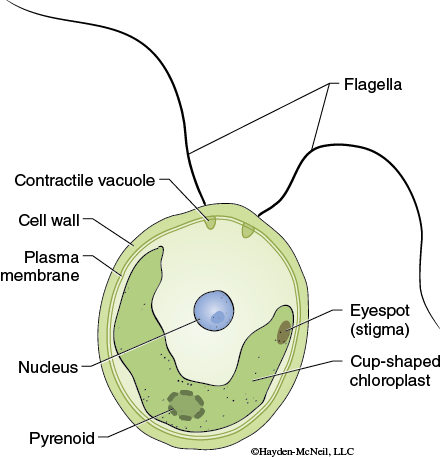Chapter 2. Population Ecology
Learning Objectives
General Purpose
Conceptual
- Gain an understanding of the basic characteristics of the model organism Chlamydomonas reinhardtii
Procedural
- Gain experience setting up controlled population ecology experiments.
- Gain experience graphing.
Background
To examine population growth, a model organism is frequently used. The unicellular green alga Chlamydomonas reinhardtii (see Figure 4-3) is the model organism you will use.

C. reinhardtii is a freshwater flagellate cell. This aquatic plant is unusual in that it is motile and can therefore move toward the light. The following link leads to a YouTube video showing Chlamydomonas cells swimming.
Since C. reinhardtii is easy to grow large numbers of in a test tube or flask, this organism has been used widely as a model for the study of various cellular and organismal characteristics. C. reinhardtii reproduces both sexually and asexually. In the light C. reinhardtii grows as a photoautotroph (using light for energy). The population growth of C. reinhardtii is dependent on light, nutrients, temperature, absence of toxins, and space for its growth. The population density (number of cells per mL) of a C. reinhardtii culture can be monitored using a spectrometer at a wavelength of 750 nm.
If you have not reviewed the information about using a spectrometer, you should look at that pre-lab material and refer to Appendix A for the general function of the spectrometer. During the growth of your C. reinhardtii cultures you will gather data for the replicates of the different treatments in your experiment. Using a standard curve or the equation provided by your instructor, you can convert your spectrometer readings to number of cells per mL.
In this lab exercise you will be examining the impact of various factors on the growth of a C. reinhardtii population. The potential growth influencing factors for a population can be separated into abiotic and biotic factors. The abiotic factors are factors that are physical and chemical components of the environment. The abiotic factors you have to choose from for this experiment are listed in Table 4-1.
Table 4-1. Abiotic factors.
In addition to abiotic factors there are also biotic factors which could impact the growth of a C. reinhardtii population. Biotic factors are those factors in an environment which are directly related to the organisms in that environment. This could be an impact from organisms of the same species as the population you are interested in or from a different species than the population you are monitoring. One example of this type of biotic factor is competition. The biotic factors you have to choose from for this experiment are listed in Table 4-2.
Table 4-2. Biotic factors.
In lab, your group will choose one of the factors (either an abiotic or a biotic) and set up an experiment for growing C. reinhardtii populations under various conditions to examine the impact of the factor you selected on the population growth. This population growth will occur over many days and your group will need to make routine measurements to track the growth of your populations of C. reinhardtii.